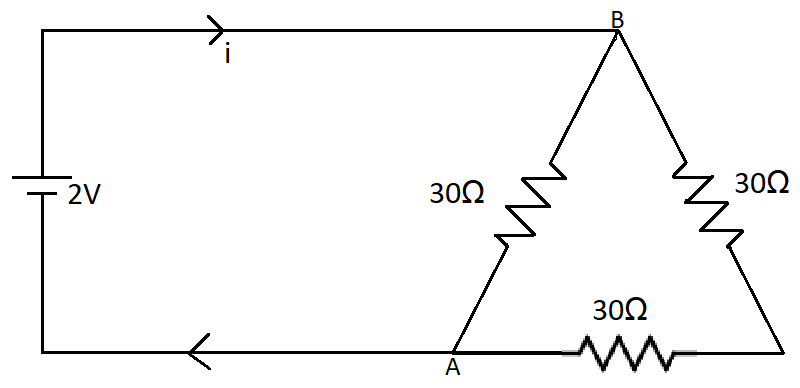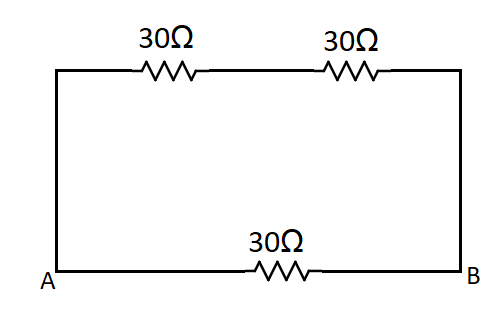Question
Question: The current in the given circuit will be : 
(A) 451 ampere
(B) 151 ampere
(C) 101 ampere
(D) 51 ampere
Solution
Hint
To find the current in the circuit we need to find the equivalent resistance that is present in the circuit. Then by using Ohm's law with the given cell of e.m.f. of 2V and the calculated equivalent resistance we can find the current in the circuit.
Formula Used: In this solution, we will be using the following formula,
Req=R1+R2+R3+.... where Req is the equivalent resistance when the resistances are placed in series.
and Req1=R11+R21+R31+.... where Req is the equivalent resistance when the resistances are placed in a parallel circuit.
And from Ohm’s law,
V=IR where V is the potential of the cell and R is the equivalent resistance.
Complete step by step answer
To solve the given problem we need to first find the equivalent resistances in the given circuit. Now in the circuit, we name the points as,

So in between the points A and B we can simplify the circuit as,

So on the top wire 2 resistances are in series, so the equivalent resistance is given by the formula
Req=R1+R2+R3+....
Therefore, Req=(30+30)Ω
⇒Req=60Ω
Now the resistance in the top and bottom wire are in parallel, so we get the equivalent resistance from the formula,
Req1=R11+R21+R31+....
So substituting R1=Req=60Ω and R2=30Ω we get
R1=R11+R21
⇒R1=601+301
On doing LCM of the denominator,
R1=601+2=603
So on taking the reciprocal we get the value of the equivalent resistance as
R=360=20Ω
So now in the given circuit, the resistance is R=20Ω and the potential across the cell is given in the figure, V=2V. So from Ohm’s law, the current in the circuit is,
i=RV
So substituting the values we get
i=202
Cancelling 2 from numerator and denominator we have,
i=101A
Therefore the correct answer is C.
Note
In the given circuit the resistances are in parallel. So the current passing gets divided into the two streams and the current in a particular stream is found by dividing the potential drop of the resistance by the resistance value. But the potential across the resistances in the two wires will be the same, that is the potential drop across the cell 2V.
